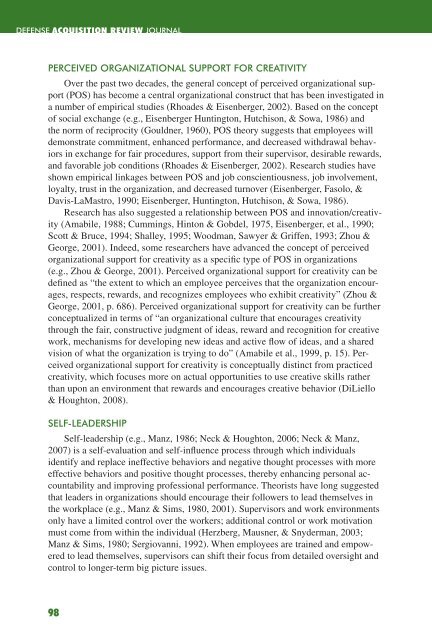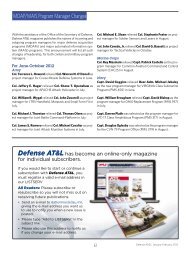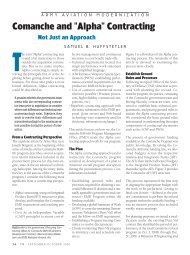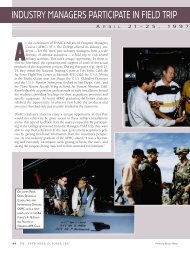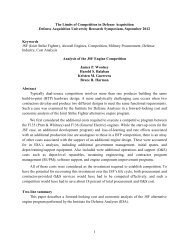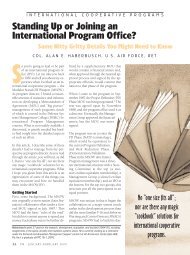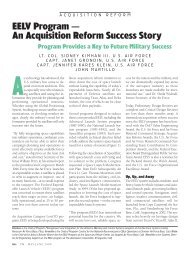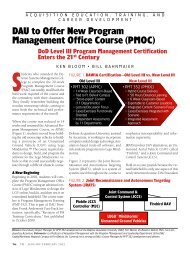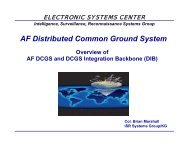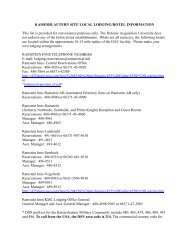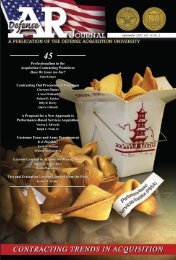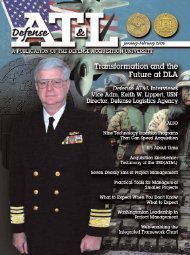Defense ARJ - Defense Acquisition University
Defense ARJ - Defense Acquisition University
Defense ARJ - Defense Acquisition University
Create successful ePaper yourself
Turn your PDF publications into a flip-book with our unique Google optimized e-Paper software.
<strong>Defense</strong> <strong>Acquisition</strong> Review Journal<br />
PerceiVeD orGaniZational suPPort for creatiVity<br />
Over the past two decades, the general concept of perceived organizational support<br />
(POS) has become a central organizational construct that has been investigated in<br />
a number of empirical studies (Rhoades & Eisenberger, 2002). Based on the concept<br />
of social exchange (e.g., Eisenberger Huntington, Hutchison, & Sowa, 1986) and<br />
the norm of reciprocity (Gouldner, 1960), POS theory suggests that employees will<br />
demonstrate commitment, enhanced performance, and decreased withdrawal behaviors<br />
in exchange for fair procedures, support from their supervisor, desirable rewards,<br />
and favorable job conditions (Rhoades & Eisenberger, 2002). Research studies have<br />
shown empirical linkages between POS and job conscientiousness, job involvement,<br />
loyalty, trust in the organization, and decreased turnover (Eisenberger, Fasolo, &<br />
Davis-LaMastro, 1990; Eisenberger, Huntington, Hutchison, & Sowa, 1986).<br />
Research has also suggested a relationship between POS and innovation/creativity<br />
(Amabile, 1988; Cummings, Hinton & Gobdel, 1975, Eisenberger, et al., 1990;<br />
Scott & Bruce, 1994; Shalley, 1995; Woodman, Sawyer & Griffen, 1993; Zhou &<br />
George, 2001). Indeed, some researchers have advanced the concept of perceived<br />
organizational support for creativity as a specific type of POS in organizations<br />
(e.g., Zhou & George, 2001). Perceived organizational support for creativity can be<br />
defined as “the extent to which an employee perceives that the organization encourages,<br />
respects, rewards, and recognizes employees who exhibit creativity” (Zhou &<br />
George, 2001, p. 686). Perceived organizational support for creativity can be further<br />
conceptualized in terms of “an organizational culture that encourages creativity<br />
through the fair, constructive judgment of ideas, reward and recognition for creative<br />
work, mechanisms for developing new ideas and active flow of ideas, and a shared<br />
vision of what the organization is trying to do” (Amabile et al., 1999, p. 15). Perceived<br />
organizational support for creativity is conceptually distinct from practiced<br />
creativity, which focuses more on actual opportunities to use creative skills rather<br />
than upon an environment that rewards and encourages creative behavior (DiLiello<br />
& Houghton, 2008).<br />
self-leaDersHiP<br />
Self-leadership (e.g., Manz, 1986; Neck & Houghton, 2006; Neck & Manz,<br />
2007) is a self-evaluation and self-influence process through which individuals<br />
identify and replace ineffective behaviors and negative thought processes with more<br />
effective behaviors and positive thought processes, thereby enhancing personal accountability<br />
and improving professional performance. Theorists have long suggested<br />
that leaders in organizations should encourage their followers to lead themselves in<br />
the workplace (e.g., Manz & Sims, 1980, 2001). Supervisors and work environments<br />
only have a limited control over the workers; additional control or work motivation<br />
must come from within the individual (Herzberg, Mausner, & Snyderman, 2003;<br />
Manz & Sims, 1980; Sergiovanni, 1992). When employees are trained and empowered<br />
to lead themselves, supervisors can shift their focus from detailed oversight and<br />
control to longer-term big picture issues.<br />
98


